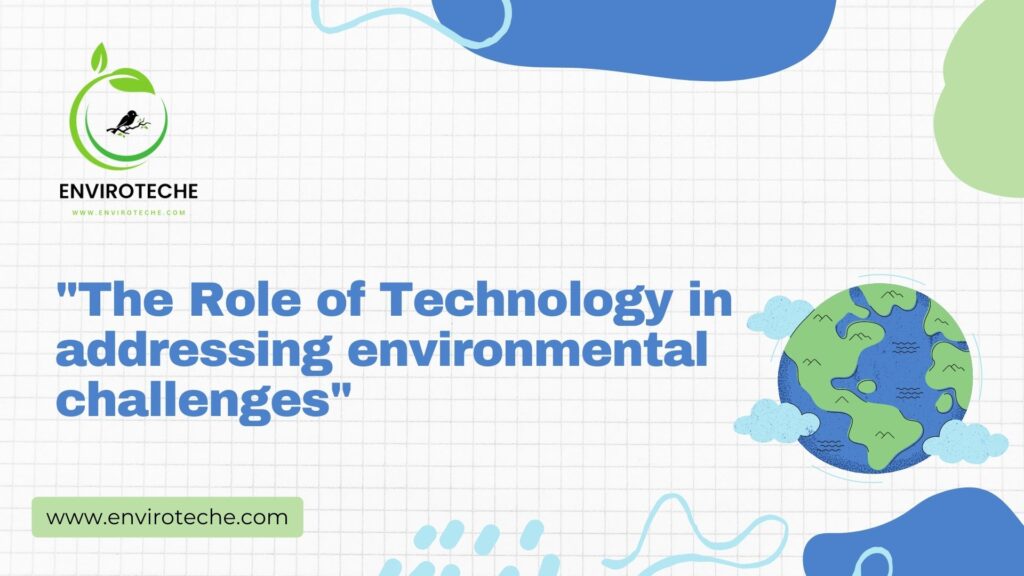
Muhammad Qasim1, Nimra Ather2
Department of Environmental Sciences, Government College University Faisalabad1
Department of Zoology, University of Agriculture Faisalabad2
Introduction:
Environmental issues like pollution, biodiversity loss, and climate change have gotten worse and environmental challenges in recent years. Due to the worsening and more widespread effects of climate change, these challenges have grown more important in recent years. Thankfully, technology has the ability to assist in overcoming these difficulties. This blog will discuss the various applications of technology and how it may be utilized to alleviate environmental issues.
- Renewable energy: Solar, wind, and hydropower are examples of renewable energy sources that have the potential to replace fossil fuels and cut greenhouse gas emissions. These sources are now more feasible alternatives because of technological improvements that have increased their efficiency and cost-effectiveness.
- Sustainable Energy Sources: The combustion of fossil fuels for energy is one of the biggest causes of climate change. In order to drastically reduce greenhouse gas emissions, sustainable energy sources like solar, wind, and hydropower should be used. These industries have become more efficient and cost-effective as a result of the invention of new technologies in these fields.
- Energy Efficiency: Energy efficiency methods can significantly reduce energy usage in addition to the use of sustainable energy sources. Consumers can now utilize less energy thanks to advancements in technology like smart meters, energy-saving appliances, and LED lighting.
- Waste Management: Reduced environmental pollution is only possible with effective waste management. The development of waste-to-energy technologies, which transform trash into electricity and lessen the amount of waste in landfills, is one example of how technology may p lay a significant role in this field.
- Sustainable Agriculture: A sizable amount of emissions of greenhouse gases and deforestation are caused by agriculture. By creating precision agricultural approaches that employ technology and information to optimize crop yields while reducing the usage of fertilizers and pesticides, technology can assist lessen the environmental effect of agriculture.
- Climate Modeling: Understanding the implications of climate change and creating solutions to lessen its effects need the use of climate modeling. Technology advancements have made it feasible to create more precise climate models that can give more specific information regarding the effects of climate change.
- Environmental Monitoring: For the purpose of identifying and resolving environmental problems, effective environmental monitoring is essential. The development of sensors and other monitoring instruments that can deliver immediate information on environmental conditions has been made feasible by technology, enabling more effective and focused responses to environmental concerns.
- Conservation and Restoration: Efforts at conservation and restoration can benefit greatly from technology. For instance, the use of drones and satellite photography can assist in the monitoring and protection of animal populations, and the creation of novel materials and methods can support attempts to restore habitat.
- Energy efficiency: Consumption of electricity and greenhouse gas emissions can be considerably reduced by increasing the energy efficiency of buildings, appliances, and transportation. The creation of more effective products and systems is one way that technology may have a significant part in this. environmental challenges
- Green transportation: Air pollution and emissions of greenhouse gases can be reduced by using electric automobiles, public transportation, and other environmentally friendly modes of transportation. Technology can aid in the creation of transportation networks that are more effective and sustainable. environmental challenges
- Water conservation: In many places of the world, there is increasing worry about water scarcity. By supporting the creation of more effective irrigation methods, reducing water leaks in infrastructure, and encouraging water-saving behaviors, technology can aid in water conservation.
- Carbon capture: Carbon dioxide from industrial operations and power plants can be captured via carbon capture devices to help lower greenhouse gas emissions. Then, the carbon that has been caught can be kept or applied to other industrial operations..
- Circular economy: An economic system known as a “circular economy” tries to reduce waste and encourage ongoing resource utilization. By offering tools for material recycling, repurposing, and reuse, technology can be a key factor in allowing a circular economy. environmental challenges
- Eco-friendly materials: Utilizing environmentally friendly components in manufacturing and construction, such as bioplastics, recycled materials, and sustainable wood products, can help lessen their negative effects on the environment. These materials can be created and produced thanks to technology. environmental challenges
Conclusion
Technology has the potential to be extremely important in solving environmental problems. Technology can contribute to lowering greenhouse gas emissions, conserving natural resources, and fostering a more sustainable future through enabling the development of more sustainable practices and systems. But technology by itself is insufficient. To make a significant difference, it must be linked with alterations in public policy and human behavior. environmental challenges
Check Other Schlorships:


